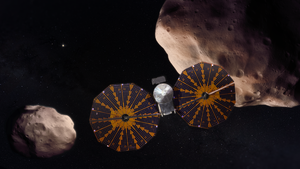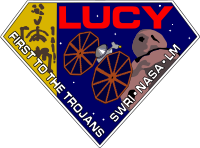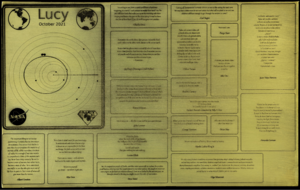لوسي (مركبة فضائية)
 Artist's conception of Lucy spacecraft flying past the Trojan asteroid 617 Patroclus and its binary companion Menoetius. Lucy will be the first mission to explore Jupiter's Trojan asteroids – ancient remnants of the outer solar system. | |||||
| طبيعة المهمة | Multiple-flyby of asteroids | ||||
|---|---|---|---|---|---|
| المشغل | NASA Goddard · SwRI | ||||
| الموقع الإلكتروني | lucy | ||||
| مدة المهمة | 12 years (planned) | ||||
| خصائص المركبة الفضائية | |||||
| مركبة الافضاء | Lucy | ||||
| المصنع | Lockheed Martin | ||||
| وزن الإطلاق | 1,500 kg (3,300 lb) | ||||
| الأبعاد | 13 m (43 ft) in long [1] Each solar panel: 6 m (20 ft) in diameter | ||||
| الطاقة | watts | ||||
| بداية المهمة | |||||
| تاريخ الإطلاق | 16 October 2021, 09:34 UTC [2] | ||||
| الصاروخ | Atlas V 401 (AV-096) | ||||
| موقع الإطلاق | Cape Canaveral, SLC-41 | ||||
| المقاول | United Launch Alliance | ||||
| الأجهزة | |||||
| High-resolution visible imager (L'LORRI) Optical and near-infrared imaging spectrometer (L'Ralph) Thermal infrared spectrometer (L'TES) | |||||

| |||||
Lucy is a NASA space probe that will complete a 12-year journey to eight different asteroids, visiting a main belt asteroid as well as seven Jupiter trojans,[3][4] asteroids which share Jupiter's orbit around the Sun, orbiting either ahead of or behind the planet. All target encounters will be fly-by encounters.[5] The Lucy spacecraft is the centerpiece of a US$981 million mission.[6]
On 4 January 2017, Lucy was chosen, along with the Psyche mission, as NASA's Discovery Program missions 13 and 14 respectively.[5][7]
The mission is named after the Lucy hominin skeleton, because the study of Trojans could reveal the "fossils of planet formation": materials that clumped together in the early history of the Solar System to form planets and other bodies.[8] The Australopithecus itself was named after the 1967 Beatles song "Lucy in the Sky with Diamonds",[9] Lucy itself is also carrying a disc made of lab-grown diamonds for her L'TES instrument.[10]
. . . . . . . . . . . . . . . . . . . . . . . . . . . . . . . . . . . . . . . . . . . . . . . . . . . . . . . . . . . . . . . . . . . . . . . . . . . . . . . . . . . . . . . . . . . . . . . . . . . . . . . . . . . . . . . . . . . . . . . . . . . . . . . . . . . . . . . . . . . . . . . . . . . . . . . . . . . . . . . . . . . . . . . .
Overview

Lucy has launched in October 2021 on the 401 variant of a United Launch Alliance Atlas V launch vehicle, after which it will gain two gravity assists from Earth; one in 2022, and one in 2024.[11] In 2025, it will fly by the inner main-belt asteroid 52246 Donaldjohanson, which was named after the discoverer of the Lucy hominin fossil.[12] In 2027, it will arrive at the ل4 Trojan cloud (the Greek camp of asteroids that orbits about 60° ahead of Jupiter), where it will fly by four Trojans, 3548 Eurybates (with its satellite), 15094 Polymele, 11351 Leucus, and 21900 Orus.[5] After these flybys, Lucy will return to Earth in 2031 for another gravity assist toward the ل5 Trojan cloud (the Trojan camp which trails about 60° behind Jupiter), where it will visit the binary Trojan 617 Patroclus with its satellite Menoetius in 2033. The mission may end with the Patroclus–Menoetius flyby, but at that point Lucy will be in a stable, 6-year orbit between the L4 and L5 clouds, and a mission extension will be possible.
Three instruments comprise the payload: a high-resolution visible imager, an optical and near-infrared imaging spectrometer, and a thermal infrared spectrometer.[13] Harold F. Levison of the Southwest Research Institute in Boulder, Colorado is the principal investigator, with Cathy Olkin of Southwest Research Institute as the mission's deputy principal investigator. NASA's Goddard Space Flight Center will manage the project.
Exploration of Jupiter Trojans is one of the high priority goals outlined in the Planetary Science Decadal Survey. Jupiter Trojans have been observed by ground-based telescopes and the Wide-field Infrared Survey Explorer to be "dark with... surfaces that reflect little sunlight".[14] Jupiter is 5.2 AU (780×106 km; 480×106 mi) from the Sun, or about five times the Earth-Sun distance.[15] The Jupiter Trojans are at a similar distance but can be somewhat farther or closer to the Sun depending on where they are in their orbits. There may be as many Trojans as there are asteroids in the asteroid belt.[16]
Development
NASA selected Lucy through the Discovery Program AO released on 5 November 2014.[17] Lucy was submitted as part of a call for proposals for the next mission(s) for Discovery Program that closed in February 2015. Proposals had to be ready to launch by the end of 2021. Twenty-eight proposals were received in all.
On 30 September 2015, Lucy was selected as one of five finalist missions, each of which received US$3 million to produce more in-depth concept design studies and analyses.[18][19][20][21] Its fellow finalists were DAVINCI, NEOCam, Psyche and VERITAS. On 4 January 2017, Lucy and Psyche were selected for development and launch.
On 31 January 2019, NASA announced that Lucy would launch in October 2021 on an Atlas V 401 launch vehicle from Cape Canaveral, Florida. The total cost for the launch is estimated to be US$148.3 million.[22] On 11 February 2019, SpaceX protested the contract award, claiming that it could launch Lucy into the same orbit at a "significantly cheaper cost". On 4 April 2019, SpaceX withdrew the protest.[23]
On 28 August 2020, NASA announced that Lucy had passed its Key Decision Point-D (KDP-D) with a "green light" to assemble and test the spacecraft and its instruments. The spacecraft instruments arrived beginning with L'LORRI on 26 October 2020.[24] On 30 July 2021, the spacecraft was transported on a C-17 transport aircraft to Florida for launch preparations, and Lucy was encapsulated into the rocket fairing on 30 September 2021. Lucy's 23-day launch window opens on 16 October 2021, and the spacecraft will make its first asteroid flyby in April 2025.[25]
Payload
The science payload includes:[1][18]
- L'Ralph - panchromatic and color visible imager (0.4-0.85 μm) and infrared spectroscopic mapper (1-3.6 μm). L'Ralph is based on the Ralph instrument on New Horizons and will be built at Goddard Space Flight Center. It will be used to measure silicates, ices, and organics at the surface.
- L'LORRI - high-resolution visible imager. L'LORRI is derived from the LORRI instrument on New Horizons and will be built at the Johns Hopkins University Applied Physics Laboratory. It will provide the most detailed images of the surface of the Trojans.
- L'TES - thermal infrared spectrometer (6-75 μm). L'TES is similar to OTES on the OSIRIS-REx mission and will be built at Arizona State University. It will reveal the thermal characteristics of the observed Trojans, which will also inform the composition and structure of the material on the surface of the asteroids.
- The radio science investigation will determine the mass of the Trojans by using the spacecraft radio telecommunications hardware and high-gain antenna to measure Doppler shifts.
The spacecraft is also adorned with a golden plaque containing its launch date, the positions of the planets at the launch date, the continents of Earth at the time of launch, its nominal trajectory, and twenty speeches, poems, and song lyrics from people such as Martin Luther King Jr., Carl Sagan, The Beatles, and more.[26]
Targets
Flybys performed by the spacecraft include:[12][27][28][29]
| Date | Target | Group | Diameter | Altitude | Type |
|---|---|---|---|---|---|
| 16 October 2022 | Earth | Terrestrial planets | 12 742 km | 300 km | Terrestrial planet. Gravity assist. |
| 13 December 2024 | Earth | Terrestrial planets | 12 742 km | 350 km | Terrestrial planet. Gravity assist. |
| 20 April 2025 | 52246 Donaldjohanson | Inner main belt, member of ~130 Myr old Erigone family | 4 km | 922 km | C-type asteroid. Lucy will flyby the asteroid from 922 km. |
| 12 August 2027 | 3548 Eurybates | Greek camp at ل4 | Eurybates: 64 km (Queta satellite: 1 km) |
1 000 km | binary C-type asteroid, largest member of the only confirmed disruptive collisional family in the Trojans. Has a small satellite. |
| 15 September 2027 | 15094 Polymele | Greek camp at ل4 | 21 km | 415 km | P-type asteroid that may be a collisional fragment of a larger P-type asteroid. Its red color suggests surface is rich in organic compounds called tholins. |
| 18 April 2028 | 11351 Leucus | Greek camp at ل4 | 34 km | 1 000 km | D-type asteroid, slow rotator taking 466 hours per rotation. |
| 11 November 2028 | 21900 Orus | Greek camp at ل4 | 51 km | 1 000 km | Characterized as a D-type and C-type asteroid by the Lucy mission team and by Pan-STARRS photometric survey, respectively. Possible binary.[30] |
| 26 December 2030 | Earth | Terrestrial planets | 12 742 km | 660 km | Terrestrial planet. Gravity assist. First spacecraft to go as far as Jupiter's orbit and return to the vicinity of the Earth.[31] |
| 2 March 2033 | 617 Patroclus-Menoetius | Trojan camp at ل5 | Patroclus: 113 km Menoetius: 104 km |
1 000 km | Binary P-type asteroids.[32] The pair orbit at a separation of 680 km. |
See also
- DESTINY+, a planned JAXA mission to flyby multiple asteroids.
- Jupiter Icy Moons Explorer, a planned ESA mission to the Jupiter system.
- OKEANOS, a proposed solar sail mission to Jupiter Trojans.
References
- ^ أ ب "The Lucy Spacecraft and Payload". Southwest Research Institute. 9 يوليو 2018.
- ^ "NASA's Lucy Mission Prepares for Launch to Trojan Asteroids" (Press release). NASA. 28 سبتمبر 2021. Retrieved 29 سبتمبر 2021.
 هذا المقال يضم نصاً من هذا المصدر، الذي هو مشاع.
هذا المقال يضم نصاً من هذا المصدر، الذي هو مشاع.
- ^ Hille, Karl (21 أكتوبر 2019). "NASA's Lucy Mission Clears Critical Milestone". NASA. Retrieved 5 ديسمبر 2020.
 هذا المقال يضم نصاً من هذا المصدر، الذي هو مشاع.
هذا المقال يضم نصاً من هذا المصدر، الذي هو مشاع.
- ^ "Lucy: The First Mission to the Trojan Asteroids". NASA. Retrieved 16 أكتوبر 2021.
- ^ أ ب ت Chang, Kenneth (6 يناير 2017). "A Metal Ball the Size of Massachusetts That NASA Wants to Explore". The New York Times.
- ^ "Watch a video tour of NASA's Lucy asteroid explorer". Spaceflight Now. 6 أكتوبر 2021. Retrieved 7 أكتوبر 2021.
- ^ Northon, Karen (4 يناير 2017). "NASA Selects Two Missions to Explore the Early Solar System". NASA.
 هذا المقال يضم نصاً من هذا المصدر، الذي هو مشاع.
هذا المقال يضم نصاً من هذا المصدر، الذي هو مشاع.
- ^ Witze, Alexandra (16 مارس 2015). "Five Solar System sights NASA should visit". Nature.
- ^ Johanson, Donald C.; Wong, Kate (2010). Lucy's Legacy: The Quest for Human Origins. Crown Publishing Group. pp. 8–9. ISBN 978-0-307-39640-2.
- ^ Facebook; Twitter; options, Show more sharing; Facebook; Twitter; LinkedIn; Email; URLCopied!, Copy Link; Print (16 أكتوبر 2021). "NASA's asteroid hunter Lucy soars into the sky with diamonds". Los Angeles Times (in الإنجليزية الأمريكية). Retrieved 16 أكتوبر 2021.
{{cite web}}:|last=has generic name (help) - ^ "NASA Awards Launch Services Contract for Lucy Mission". nasa.gov. NASA. 31 يناير 2019. Retrieved 29 مارس 2021.
{{cite web}}: CS1 maint: url-status (link) هذا المقال يضم نصاً من هذا المصدر، الذي هو مشاع.
هذا المقال يضم نصاً من هذا المصدر، الذي هو مشاع.
- ^ أ ب Dreier, Casey; Lakdawalla, Emily (30 سبتمبر 2015). "NASA announces five Discovery proposals selected for further study". The Planetary Society.
- ^ Leibold, Rob (2 أكتوبر 2015). "SwRI awarded US$3 million NASA contract to develop mission to Jupiter's Trojan asteroids" (Press release). Southwest Research Institute.
- ^ "PIA16211: Trojan Colors Revealed (Artist's Concept)". NASA. 15 أكتوبر 2012.
 هذا المقال يضم نصاً من هذا المصدر، الذي هو مشاع.
هذا المقال يضم نصاً من هذا المصدر، الذي هو مشاع.
- ^ Wall, Jennifer (1 يونيو 2015). "What Is Jupiter?". NASA.
 هذا المقال يضم نصاً من هذا المصدر، الذي هو مشاع.
هذا المقال يضم نصاً من هذا المصدر، الذي هو مشاع.
- ^ Dreier, Casey; Lakdawalla, Emily (30 سبتمبر 2015). "NASA announces five Discovery proposals selected for further study". The Planetary Society.
- ^ "FY 2021 PRESIDENT'S BUDGET REQUEST SUMMARY" (PDF). NASA. Retrieved 29 مارس 2021.
{{cite web}}: CS1 maint: url-status (link) هذا المقال يضم نصاً من هذا المصدر، الذي هو مشاع.
هذا المقال يضم نصاً من هذا المصدر، الذي هو مشاع.
- ^ أ ب Leibold, Rob (2 أكتوبر 2015). "SwRI Awarded US$3 Million NASA Contract To Develop Mission To Jupiter's Trojan Asteroids" (Press release). Southwest Research Institute.
- ^ Brown, Dwayne C.; Cantillo, Laurie (30 سبتمبر 2015). "NASA Selects Investigations for Future Key Planetary Mission". NASA.
 هذا المقال يضم نصاً من هذا المصدر، الذي هو مشاع.
هذا المقال يضم نصاً من هذا المصدر، الذي هو مشاع.
- ^ Clark, Stephen (24 فبراير 2014). "NASA receives proposals for new planetary science mission". Spaceflight Now.
- ^ Kane, Van (2 ديسمبر 2014). "Selecting the Next Creative Idea for Exploring the Solar System". The Planetary Society.
- ^ "NASA Awards Launch Services Contract for Lucy Mission". NASA. 31 يناير 2019.
 هذا المقال يضم نصاً من هذا المصدر، الذي هو مشاع.
هذا المقال يضم نصاً من هذا المصدر، الذي هو مشاع.
- ^ Foust, Jeff (5 أبريل 2019). "SpaceX drops protest of NASA launch contract". SpaceNews.
- ^ "Johns Hopkins APL Delivers First Instrument for NASA's Lucy Mission | APL Civil Space". civspace.jhuapl.edu. Retrieved 1 أكتوبر 2021.
- ^ Bartels, Meghan (31 أغسطس 2020). "NASA asteroid mission Lucy begins spacecraft assembly before 2021 launch". SpaceNews.
- ^ "The Lucy Plaque - Lucy Mission". lucy.swri.edu. Retrieved 5 أكتوبر 2021.
- ^ "Lucy: Surveying the Diversity of Trojan Asteroids, the Fossils of Planet Formation" (PDF). Southwest Research Institute. 2015. Retrieved 11 يوليو 2017.
- ^ (March 2017) "Lucy: Surveying the Diversity of the Trojan Asteroids, the Fossils of Planet Formation" in 48th Lunar and Planetary Science Conference. 20–24 March 2017 The Woodlands, Texas.. LPI Contribution No. 1964, id. 2025.
- ^ "Mission Targets". Lucy. Southwest Research Institute. 25 يونيو 2018.
- ^ Noll, K. S.; Grundy, W. M.; Buie, M. W.; Levison, H. F.; Olkin, C.; Marchi, S.; Brown, M. E.; Mottola, S. (22 August 2018), 15622 - Confirmation of a Binary Companion to 21900 Orus, Space Telescope Science Institute, http://www.stsci.edu/hst/phase2-public/15622.pdf
- ^ "Lucy Mission". NASA. Retrieved 15 أكتوبر 2021.
 هذا المقال يضم نصاً من هذا المصدر، الذي هو مشاع.
هذا المقال يضم نصاً من هذا المصدر، الذي هو مشاع.
- ^ Sanders, Robert (1 فبراير 2006). "Binary asteroid in Jupiter's orbit may be icy comet from solar system's infancy" (Press release). University of California Berkeley.
External links
- Mission website at NASA.gov
- NASA's New Discovery Missions: Psyche and Lucy at YouTube
- Lucy: NASA's mission to Jupiter's Trojans at eoPortal
- CS1 errors: generic name
- CS1 الإنجليزية الأمريكية-language sources (en-us)
- CS1 maint: url-status
- Short description is different from Wikidata
- Use American English from February 2021
- All Wikipedia articles written in American English
- Use dmy dates from February 2021
- Spaceflight infobox standardisation - phase 2
- Articles with hatnote templates targeting a nonexistent page
- Portal-inline template with redlinked portals
- Pages with empty portal template
- Discovery Program
- Jupiter trojans
- Missions to asteroids
- 2021 in spaceflight
- Proposed NASA space probes









